#Thyra of Denmark
Explore tagged Tumblr posts
Text

Maria Feodorovna with her siblings Thyra and Valdemar and their families.
#romanov#danish royal family#dagmar of denmark#maria feodorovna#thyra of denmark#valdemar of denmark#george of greece#margrethe of denmark#margareta of sweden#and others#my collection#press photos
33 notes
·
View notes
Text

Princesses Dagmar and Thyra of Denmark, 1863
<source>
#ooh new rare!#princess dagmar of denmark#maria feodorovna#princess thyra of denmark#crown princess thyra of hanover#dagmar of denmark#Thyra of Denmark#1863#circa 1863#1860s#rare photos
251 notes
·
View notes
Text

Princess Lovisa of Sweden with Princess Thyra of Denmark. 1870s.
#aesthetic#art#art history#fashion#historical fashion#victorian#historical art#women in art#victorian aesthetic#women#1870s#1870s fashion#1870s dresses#1870s aesthetic#royalty aesthetic#queen louise of denmark#thyra of Denmark#danish royalty#Danish royals#Swedish royals#Sweden#Denmark#vintage photography#photography#fashion photography
56 notes
·
View notes
Text

Thyra of Denmark, Crown Princess of Hanover, and her three daughters (left to right): Marie Louise,, Olga, and Alexandra
31 notes
·
View notes
Text


Grand Duke Mikhail Alexandrovich and his cousin Princess Thyra of Denmark at Fredensborg Castle 1903.
3 notes
·
View notes
Text

Thyra of Denmark
0 notes
Text
Women's history just got richer
By Mindy Weisberger, CNN
More than 1,000 years ago, carvers in what is now Denmark set their chisels to rock to etch runestones — monuments to Viking leaders naming their deeds and achievements. Two groups of runestones mention a woman named Thyra, and new analysis of the carvings suggests that the runes on both sets of stones were inscribed by the same artisan and refer to the same woman: a Viking queen of considerable power.
Researchers from Denmark and Sweden used 3D scans to analyze carvings on the runestones, finding telltale clues that marked the individual style of the person who carved them. That carver’s repeated mention of Thyra’s name — a rare occurrence for Viking-era women — suggested that Thyra was a powerful sovereign who likely played a pivotal role in the birth of the Danish realm, the scientists reported Wednesday in the journal Antiquity.
“To learn more about the rune-carver and those named on the stone is fascinating,” said Dr. Katherine Cross, a lecturer at York St. John University in the UK who researches and teaches the history of early medieval northern Europe. She was not involved in the study.
“We can only understand early medieval sources once we can think about who made them and why,” Cross told CNN in an email.
One set of runes came from a pair of monuments known as the Jelling stones, erected in the town of Jelling around 965. The larger Jelling stone is often referred to as “Denmark’s birth certificate,” as it’s the first monument to name the land as its people pivoted to Christianity, according to the National Museum of Denmark in Copenhagen.
Both Jelling runestones also named a royal figure: Queen Thyra, mother of then-reigning King Harald Bluetooth. The smaller stone was raised in her honor by her husband (and Harald’s father) King Gorm, calling her “Denmark’s strength/salvation” (or “Denmark’s adornment,” depending on the translation, the researchers noted in the study). Harald commissioned the larger stone, to honor both of his royal parents.
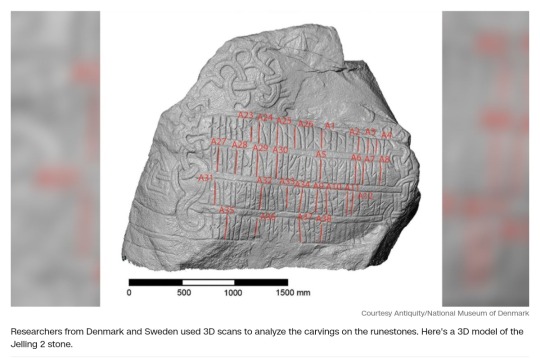
In another set of four Viking-era monuments, known collectively as the Bække-Læborg group, two runestones mention a woman named Thyra. Those stones are associated with a carver named Ravnunge-Tue, but experts disagreed on whether that Thyra was Harald’s mother, said lead study author Dr. Lisbeth Imer, a curator and senior researcher at the National Museum of Denmark specializing in the study of runes and ancient inscriptions.
Before the new investigation, it was unknown who had carved the Jelling stones. Confirming that their carver was Ravnunge-Tue would strengthen the connection between the Jelling and Bække-Læborg runestones, Imer told CNN in an email.
“Then it is much more reasonable to suggest that it was in fact the same Thyra,” she said.
A question of style
Some details in ancient runestones that indicate a carver’s individual style are visible to a trained expert’s eye, such as the language or the basic shape of the runes. Other details are harder to detect, Imer said.
“What you cannot see with the naked eye is the carving technique,” she said.
To get a closer look at the carvings, the researchers took scans of the stones and created 3D digital models, then measured the runes’ grooves with a software tool that weighed variables such as angle, depth and cutting rhythm. Together, these variables can create a unique profile for a carver.
“Every rune carver develops his own motor skill and holds the tools in a certain angle, strikes with a certain strength,” Imer said. “The motor skill is individual and other individuals cannot copy that.”
When the researchers compared runes from Jelling 2 (the larger of the two Jelling stones) and the Læborg stone from the Bække-Læborg group, they found striking similarities, such as height of the runes, straightness of the main staves and length and placement of rune branches.
“In the Læborg and Jelling inscriptions you can follow the cutting rhythm of Ravnunge-Tue as one deep stroke of the chisel followed by two not so deep ones: DAK, dak-dak, DAK, dak-dak,” Imer said via email. “It is ALMOST like hearing the heartbeat of a person that lived so long ago.”
Jelling 1 was more eroded, so its markings were harder to analyze. But if the Læborg runestone was Ravnunge-Tue’s handiwork, Jelling 2 was likely his as well, Imer said. It would mean that the Queen Thyra mentioned twice in the Bække-Læborg group — on Læborg and on the stone Bække 1 — was the same person commemorated on the Jelling stones, the study authors concluded.
In recent years, archaeologists have revised prior interpretations of Viking warrior burials as exclusively male, finding that Viking women were fighters, too. The new findings add to the picture of influential Viking women holding prominent roles in statecraft as well as on the battlefield.
“This research highlights how Viking-Age women wielded power through political authority and patronage, not just violence,” Cross said.
What’s more, the fact that Thyra is mentioned on four runestones offers strong evidence of her importance, Imer added. Fewer than 10 runestones in Denmark from the pre-Christian era mention women at all — and four of those are of Queen Thyra.
“Runestones in Denmark were mostly erected in honour of men, but Thyra is commemorated on more runestones than any other person in Viking Age Denmark,” Imer said. “She must have held extreme power and social position.”
Mindy Weisberger is a science writer and media producer whose work has appeared in Live Science, Scientific American and How It Works magazine.
#Denmark#women in history#Queen Thyra#Viking Queen#Jelling Stones#King Harald Bluetooth#King Gorm#Bække-Læborg group#a carver named Ravnunge-Tue
204 notes
·
View notes
Text
"Therefore, the references to Thyra on both groups of stones likely refer to the same person – the Danish Queen and mother of Harald Bluetooth. This indicates that she was a particularly powerful and celebrated individual. It is likely that she held land and authority in her own right, not only through her husband. “No other Viking man or woman in Denmark has been mentioned on that many runestones,” says Dr Imer, “and it underlines her undeniable importance for the assembling of the realm under the rule of her son, Harald Bluetooth.”
Importantly, this means that women likely had more influence in Viking-Age Denmark than previously believed. It indicates that Viking women may have been able to hold power in their own right and rule on behalf of their husbands or under-age sons. It also has important implications for our knowledge on the formation of the Danish state. The authors conclude:
If we accept that runestones were granite manifestations of status, lineage and power, we may suggest that Thyra was indeed of royal, Jutlandic descent. Both Gorm and Harald refer to her in the runestone texts and Ravnunge-Tue describes her as his dróttning, that is, ‘lady’ or ‘queen’. Combined with the designation of Thyra as Danmarkaʀ bót, ‘Denmark’s strength/salvation’, these honours point towards a powerful woman who held status, land and authority in her own right. The combination of the present analyses and the geographical distribution of the runestones indicates that Thyra was one of the key figures—or even the key figure—for the assembling of the Danish realm, in which she herself may have played an active part.""
#thyra#history#women's history#queens#women in history#denmark#danish history#vikings#10th century#medieval women#middle ages#medieval history#runestones#harald bluetooth
68 notes
·
View notes
Text
𝙲𝚑𝚘𝚌𝚘𝚕𝚊𝚝𝚎 𝚌𝚊𝚛𝚍𝚜 𝚘𝚏 𝚁𝚘𝚢𝚊𝚕 𝚠𝚘𝚖𝚎𝚗 👑✨🍫
(𝙿𝚊𝚛𝚝 𝟹 𝚘𝚞𝚝 𝚘𝚏 𝟺)
~~~~~~~~~~~~~~~~~~~~~~~~~~~~~~~~~~~~~~~~~~~~~~~
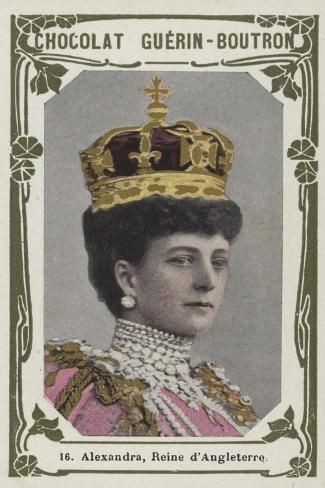
Queen Alexandra 𝚘𝚏 𝚝𝚑𝚎 𝚄𝚗𝚒𝚝𝚎𝚍 𝙺𝚒𝚗𝚐𝚍𝚘𝚖, née Princess Alexandra of Denmark.
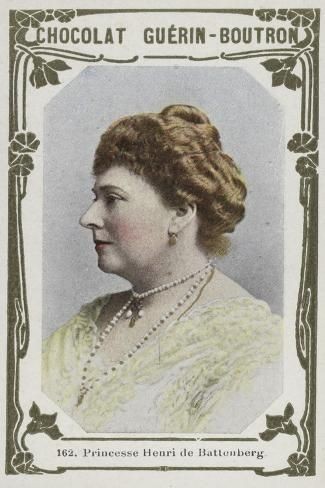
Princess Beatrice of Battenberg, née Princess Beatrice of the United Kingdom.

Princess Andrew of Greece and Denmark, née Princess Alice of Battenberg.
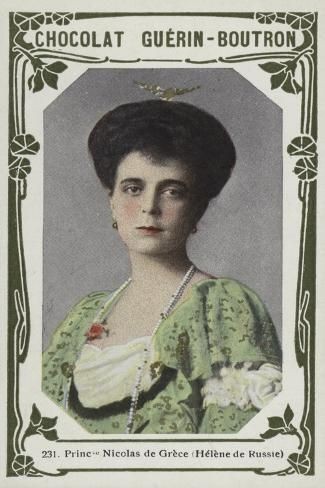
Princess Nicholas of Greece and Denmark, née Grand Duchess Elena Vladimirovna.
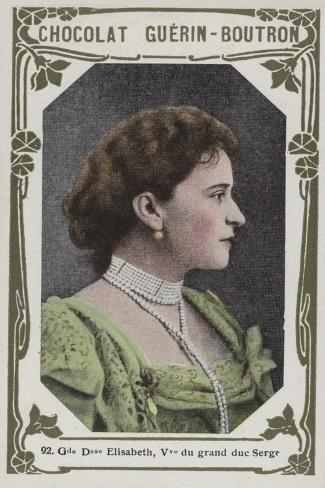
Grand Duchess Elisabeth Feodorovna, née Princess Elisabeth of Hesse.
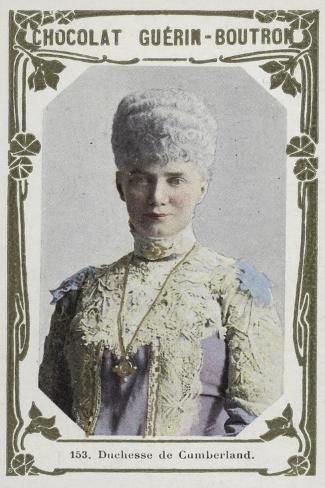
Crown Princess Thyra of Hanover, née Princess Thyra of Denmark.

Princess Olga of Hanover
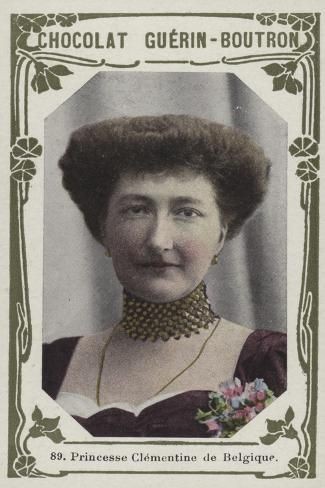
Princess Clementine of Belgium

Queen Alexandrine of Denmark, née Duchess Alexandrine of Mecklenburg-Schwerin.
#queen alexandra#alexandra of denmark#princess beatrice of battenberg#princess alice of battenberg#princess alice of greece and denmark#grand duchess elena vladimirovna#grand duchess elisabeth feodorovna#elisabeth of hesse#princess thyra of denmark#crown princess thyra of hanover#princess olga of hanover#princess clementine of belgium#queen alexandrine of denmark#alexandrine of mecklenburg-schwerin#chocolate cards
19 notes
·
View notes
Text

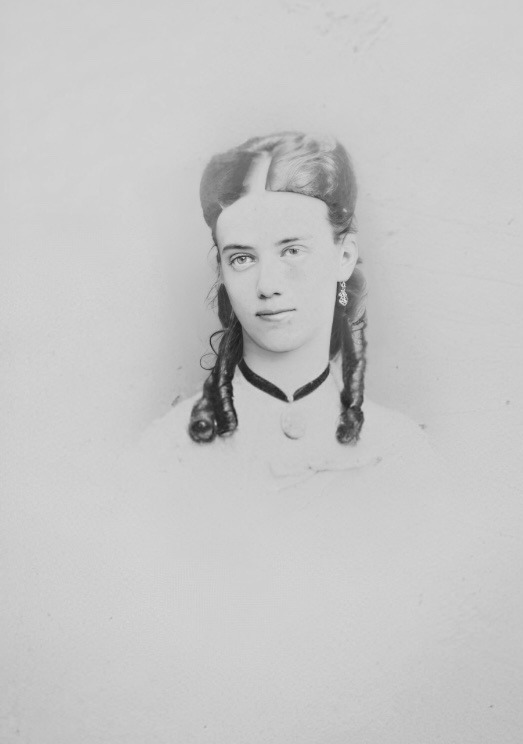
”The youngest of families tends to be treated with special tenderness, and that was the case here as well. Both the parents and the entire Danish people loved the young Prince [Waldemar] and Princess [Thyra], […] As also the youngest of the capital's "favourites", Princess Tyra, left her childhood home to take her place by the Duke of Cumberland's side, there was sorrow mixed in the festive atmosphere.”
Kong Christian IX; Et mindeskrift by J.C Jorgennsen & co, 1906.
#Princess Thyra of Denmark#Danish Royal Family#Royalty#Royal History#House of Hanover#Thyra of Cumberland#Sweet Thyra… :’(
26 notes
·
View notes
Text

Queen Alexandra with her father, King Christian IX of Denmark, and sister Thyra, Duchess of Cumberland and brother ‘Willie’ and his impressive moustache with his back turned.
(x)
39 notes
·
View notes
Text
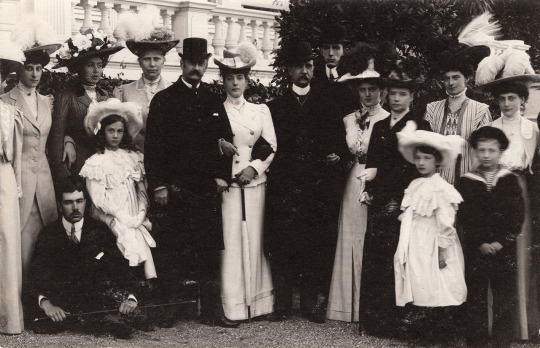
Gathering of Danish and Swedish Royal Families.
At center you can see King Frederick VIII of Denmark, his sister Queen Alexandra, brother King George I of the Hellenes (with his granddaughter Maria Pavlovna the Younger), and sister Maria Feodorovna. Frederick married Louise of Sweden (behind him), and one of their daughters, Ingeborg, married back into the Swedish family herself. Two of her daughters, Margaretha and Martha, are seen here, but her most famous, Astrid, is not.
#romanov#maria pavlovna the younger#maria feodorovna#dagmar of denmark#alexandra of denmark#frederick viii of denmark#louise of sweden#margaret of connaught#william of sweden#margaretha of sweden#martha of sweden#martha of norway#thyra of denmark#ingeborg of denmark#danish royal family#swedish royal family#my collection
30 notes
·
View notes
Text

12 notes
·
View notes
Text
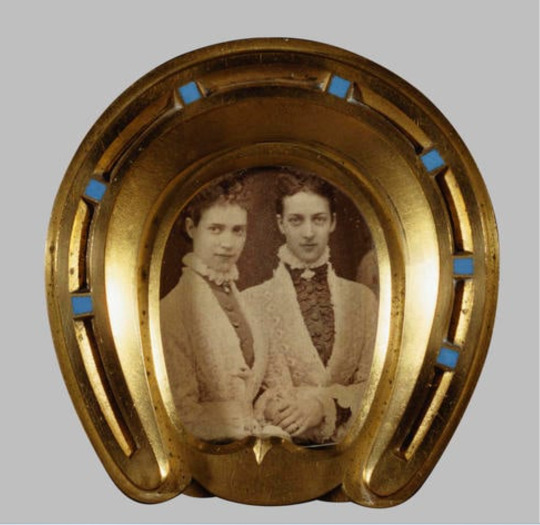

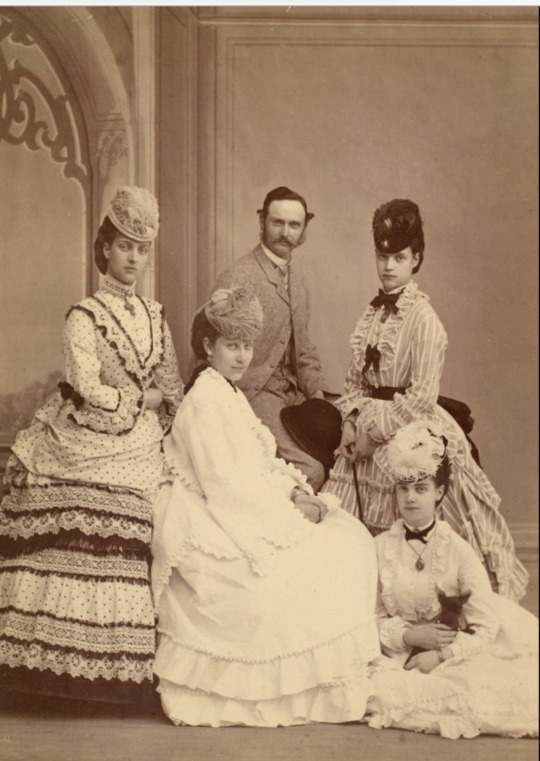


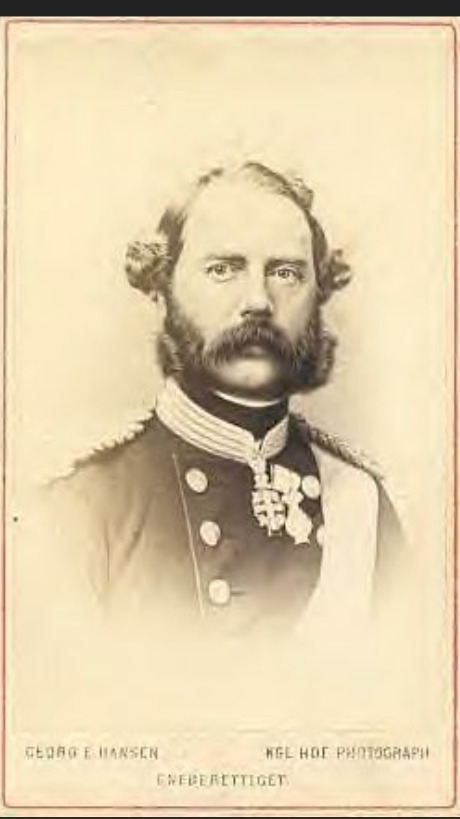
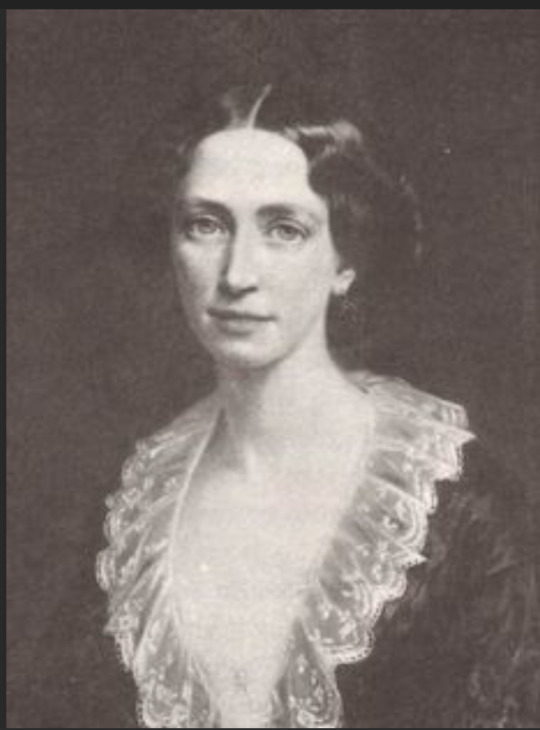
Photographs: 1. Alexandra and her younger sister Dagmar; 2. The Danish Royal Family: From left to right: Dagmar (Marie Feodorovna), the little one by Dagmar's knee should be Prince Valdemar, the youngest; standing in back of the child, the oldest male, future King Frederick VIII; King Christian the IX is in the middle, standing in back of his wife Louise; standing by Louise is Princess Thyra; next to Thyra is the future Queen Alexandra; standing in the back, between Thyra and Alexandra, is George, the future King of the Helenes; 3. In this picture, a very beautiful Princess Alexandra; sitting by her is Princess Lovisa of Sweden, the wife of Frederick, who is standing by her; next to Frederick is Dagmar, and sitting on the floor holding a little dog is Thyra; 4. Christian IX 5. Queen Louise; 6. Christian IX 7. Queen Louise
The Danish Royal Family
King Christian IX of Denmark (1818 - 1906) and Queen Louise of Denmark (1817 - 1898) nee Louise of Hesse-Kessel and their children
This Wednesday, a little love for the Danish Royal Family, who gave us Queen Alexandra of England, one of the most beautiful queens to sit on a throne since photography was created (no makeup, Botox, fillers, plastic surgery), and her sister, Empress Maria Feodorovna (Princess Dagmar of Denmark) one of the prettiest and most beloved Empresses of all the Russias.
So where did all that beauty come from? Most of us have seen photographs of Christian IX and Queen Louise in their older years. At least I had not seen them young. I looked for some photos, and I am including them here. Both of them were good-looking. Louise had a pretty face and beautiful eyes. And so did Christian! He was not bad-looking at all, tall and slim. The little cleft on Alexandra's chin apparently came from her father. The girls had good genes.
The House of Glücksburg, to which Christian IX and Queen Louise belonged, is a collateral branch of the German House of Oldenburg. Its members have reigned at various times in Denmark, Norway, Sweden, Iceland, Greece, and several northern German states.
King Christian IX and Queen Louise were double cousins. King Christian was called the "father-in-law of Europe" on account of the marriage of his children to foreign princes and princesses.
Current monarchs King Charles III of the United Kingdom, Queen Margrethe II of Denmark, and King Harald V of Norway, as well as former queens consort Ann Marie of Greece and Sofia of Spain, are patrilineal members of cadet branches of the House of Glücksburg. (gcl)
#romanov dynasty#danish royal family#Queen Louise of denmark#Louise of Hesse-Kessel#King Christian IX of Denmark#Princess Alexandra of Denmark#Princess Dagmar of Denmark#Princess Lovisa of Sweden and Norway#Thyra#Crown Princess of Hanover
18 notes
·
View notes
Text
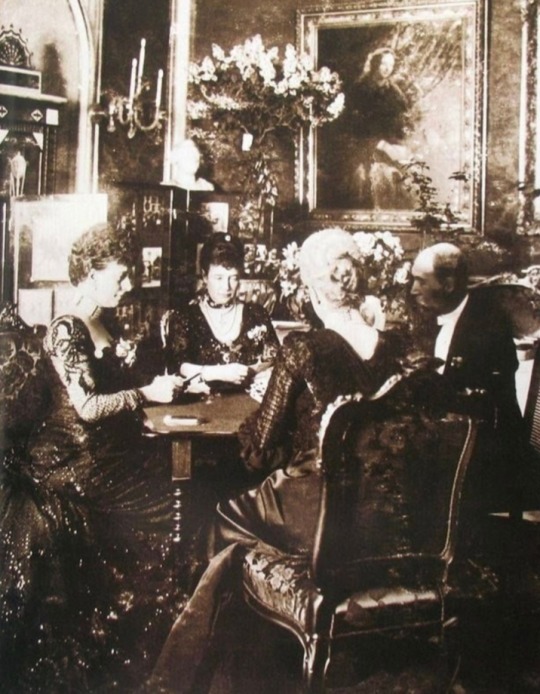
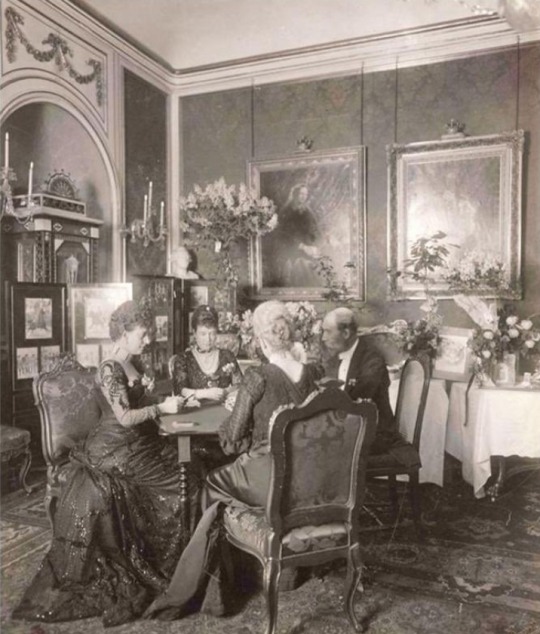

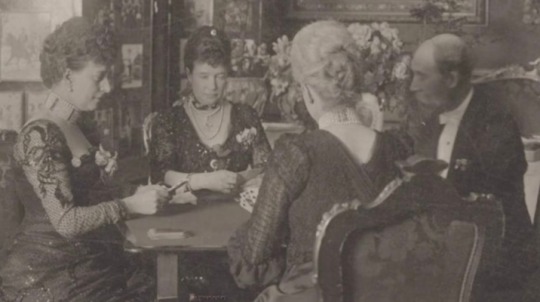
Queen Alexandra of the United Kingdom, Empress Maria Feodorovna of Russia, Princess Thyra, and their father King Christian IX of Denmark playing cards.
—
Alexandra of Denmark (Alexandra Caroline Marie Charlotte Louise Julia; 1 December 1844 – 20 November 1925) was Queen of the United Kingdom and the British Dominions, and Empress of India from 22 January 1901 to 6 May 1910 as the wife of King-Emperor Edward VII.
—
Maria Feodorovna (26 November 1847 – 13 October 1928), known before her marriage as Princess Dagmar of Denmark, was Empress of Russia from 1881 to 1894 as the wife of Emperor Alexander III.
She was the second daughter of Christian IX of Denmark and Louise of Hesse-Kassel.
Maria's eldest son became the last Russian monarch, Emperor Nicholas II.
Maria lived for 10 years after Bolshevik functionaries murdered Nicholas and his immediate family in 1918.
—
Princess Thyra of Denmark (Thyra Amalie Caroline Charlotte Anna; 29 September 1853 – 26 February 1933) was the youngest daughter and fifth child of Christian IX of Denmark and Louise of Hesse-Kassel.
In 1878, she married Ernest Augustus, the exiled heir to the Kingdom of Hanover.
As the Kingdom of Hanover had been annexed by Prussia in 1866, she spent most of her life in exile with her husband in Austria.
—
Christian IX (8 April 1818 – 29 January 1906) was King of Denmark from 15 November 1863 until his death in 1906.
From 1863 to 1864, he was concurrently Duke of Schleswig, Holstein and Lauenburg.
#Alexandra of Denmark#Queen Alexandra of the United Kingdom#Empress Maria Feodorovna of Russia#Princess Dagmar of Denmark#Princess Thyra of Denmark#King Christian IX of Denmark#Prince Christian of Schleswig-Holstein-Sonderburg-Beck#House of Glücksburg#House of Hesse#House of Romanov#House of Hanover#British Royal Family#Danish Royal Family#Russian Royal Family
9 notes
·
View notes
Text
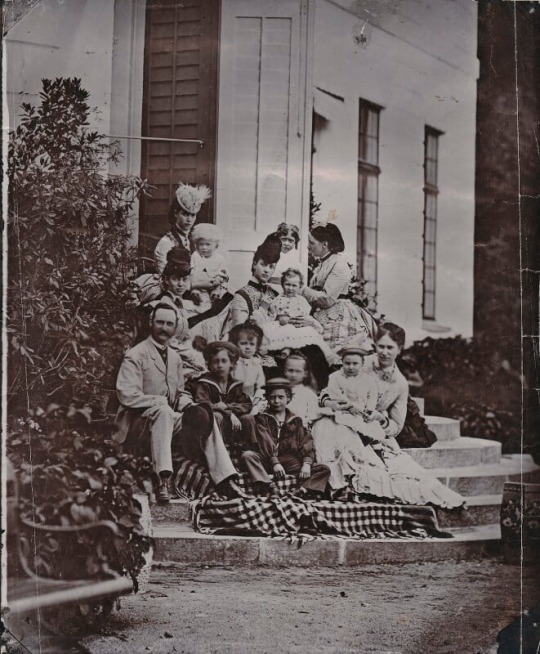
Danish royal family 1872
Tsesarevna Maria Feodorovna with her son Grand Duke George Alexandrovich, Princess Alexandra of Wales and her daughter Princess Maud and Princess Victoria with her grandmother Queen Louise, Crown Prince Frederick and his sister Princess Thyra, Prince Albert Victor, Grand Duke Nicholas, Prince George (I don't really know who the girl next to Nicholas is but it might be Princess Louise of Wales), Princess Louise and her son Prince Christian of Denmark.
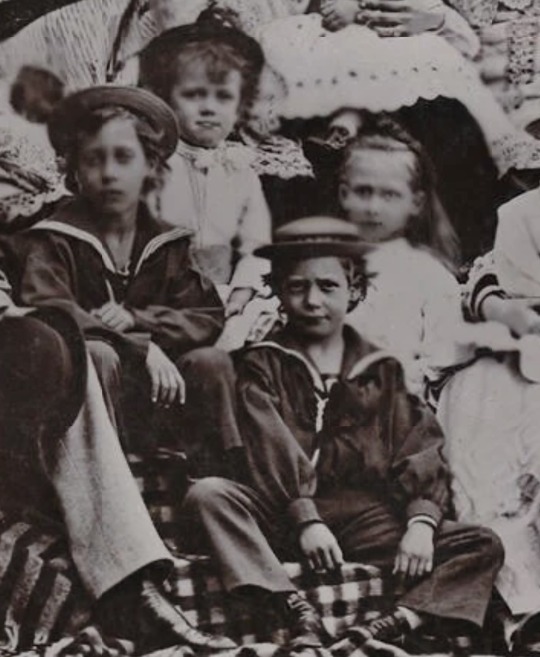
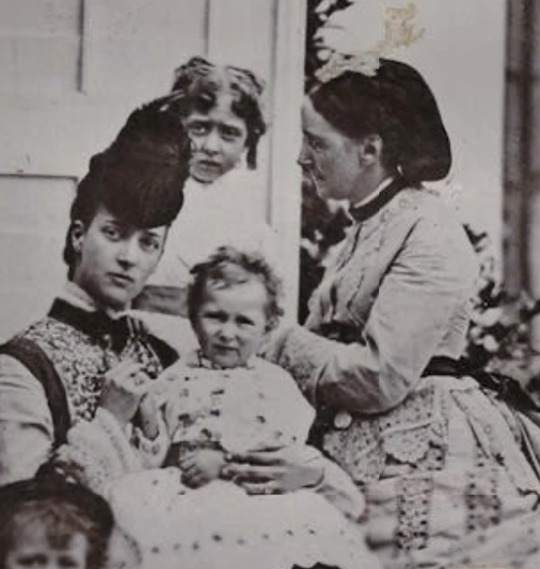

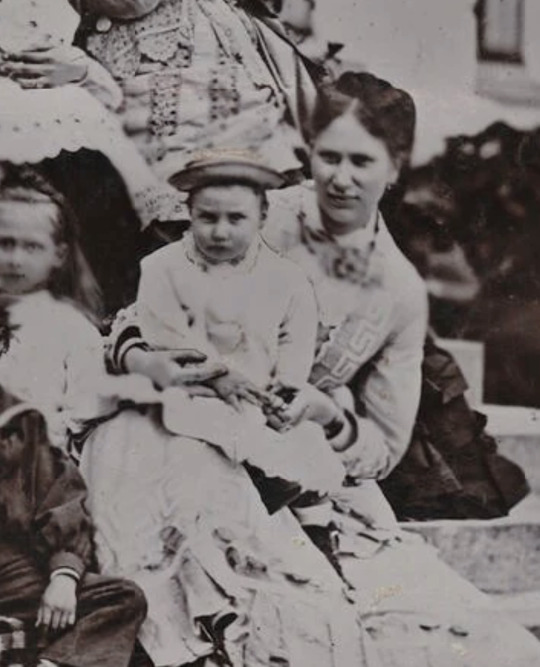
#queen louise of denmark#Frederick VIII#maria feodorovna#queen alexandra#Princess Thyra of Denmark#Princess louise of Sweden#albert victor#George v#nicholas ii#george alexandrovich#Victoria of Wales#maud of wales#Christian X#danish royal family#1870s
77 notes
·
View notes